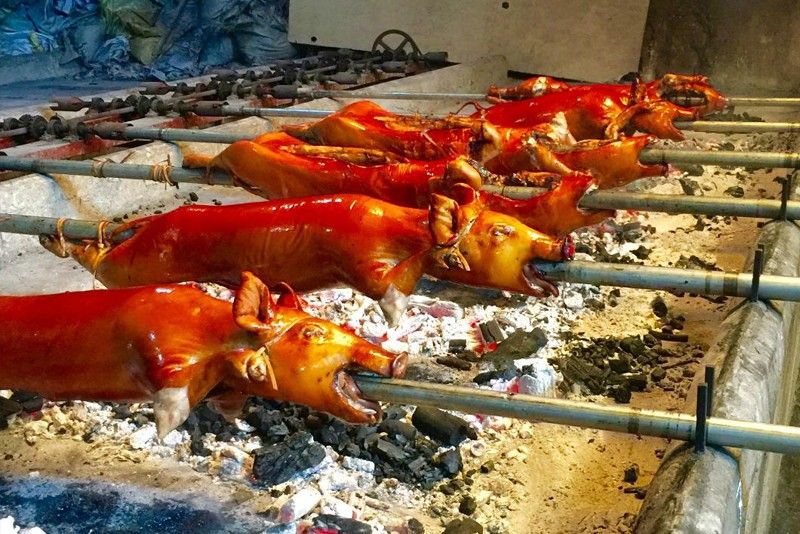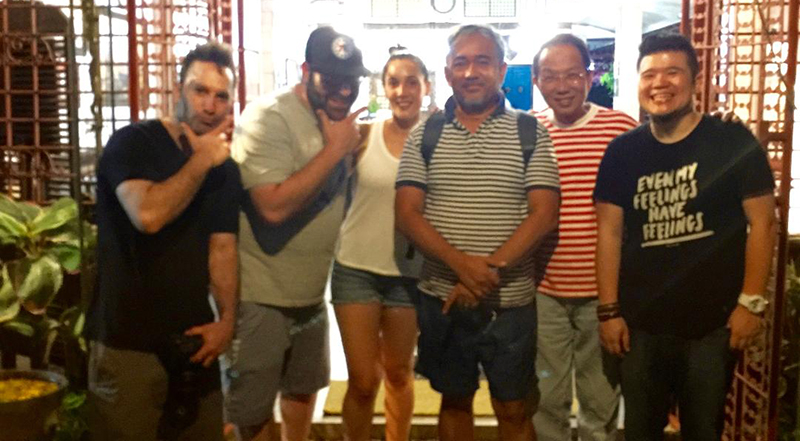Cavite (and Manila) chronicle


It was hypnotic watching them cook at Leonardo’s Lechon.
After getting our fill of food and history from Cavite City and Imus, I drove the group to Silang to finish off the Cavite tour. Our group was led by food historian and author Ige Ramos, with me driving. We were taking Top Chef alum Leah Cohen on a quick tour of Cavite and we were joined by her husband Ben Byruch who leads (together with Leah) Pig and Khao restaurant in New York and photographer Dylan Kushel. We did a quick stopover in Tagaytay so they could finally get to see Taal and take pictures.
I first took them to Malipayon Farms, owned by Gejo Jimenez. Gejo, whose farm now supplies organic vegetables to some of the metro’s top restaurants, has become a good friend and I wanted to give Leah and the gang a look (and an opportunity for Dylan to take pictures) at some of our local produce right at the source. Local lettuce, carrots, micro greens, galangal and chilies were the highlights of our quick tour. It’s easy for us here in the Philippines to take some of our ingredients for granted, and Leah was quick to remind me of that. She told me how difficult it was to source ingredients like lemongrass and ginger, particularly ones as young and fresh as we get them.

The gang happy and full: Dylan Bushel, Ben Byruch, Leah Cohen, Ige Ramos, Sonny Lua and the author Sharwin Tee
Our stomachs rumbling, I then took them to Asiong’s for merienda cena. Just a short 10-minute drive from Tagaytay, the proudly Caviteño restaurant is led by Sonny Lua, another great friend. In the beautifully serene garden Sonny designed himself, we feasted on some of Asiong’s greatest hits. First, we had the Pancit Pusit. A recipe I learned from Sonny himself when I first visited Cavite a couple of years ago, the dish is one of the country’s most unique. Vermicelli cooked with squid and squid ink, topped with vegetables and pickled kamias, the dish is visually stunning and the taste is equally so. Since the gang had never been to Tagaytay, I made sure to order crispy tawilis and bulalo as well to give them a taste of the favorites. Then, just because I was afraid they wouldn’t have enough, I ordered a crispy pata kare kare with Sonny’s homemade bagoong. There were long bouts of silence around the table and believe me, it wasn’t because of the jetlag; everyone was just busy eating.
As the furious eating slowly died down many (many) minutes later; the conversations became equally delicious, as Sonny and Gejo joined us. Of particular interest was the use of squid ink in the culinary world. Many of us had held the belief that the use of squid ink was a European thing, but Ige had come across documentary evidence that show Filipinos using squid ink before the Spaniards did. I know there can be many debates arguing this development, but understanding how we Filipinos love to use everything edible in our food, I believe it is true.
The following day, with Leah and Ben writing down a list of ingredients they need pictures of for their cookbook, we headed to Farmer’s Market in Cubao to check off that list. Whenever I visit other countries, I always look forward to visiting markets myself, so I appreciate it when guides and friends take me on a market tour. I actually like to joke about how Farmer’s Market should start giving me royalties as Leah and the gang was probably the fourth or fifth group I’ve brought there. In any case, I was glad to see Dylan in his element, taking some stunning pictures of not only the market but the Filipinos working in the market as well. Being the friendly people we are, a lot of the vendors posed willingly with smiles holding up their produce.
While Dylan was hard at work, I got to talk shop with Leah, discussing the different ways we use the vegetables we were perusing. I was impressed with her knowledge of Filipino ingredients despite growing up in the US, and it strengthened my resolve to make sure to drop by her restaurant the next time I had a chance to go to New York.

The Pancit Pusit of Asiong is stunning visually and flavor wise(left). Who can refuse crispy pata kare kare (center)? Prawns with garlic butter at the dampa is great any time of the day(right).
With all the work done, I figured it was time to eat brunch! I took the liberty of buying ingredients in the market and we headed to the dampa section of the market to have them cooked. Leah got a lapu lapu head while I got the vegetables and kamias for sinigang. Then, I got some prawns to be cooked in garlic butter and clams in black bean sauce. Finally, I got some lato, arosep, to make into a salad. It was their first time to try lato, and I am glad I have converted more people into loving it. I don’t think enough restaurants serve it! Now, an all seafood brunch might be weird to some, but trust me, it’ll get your day on the right start.
With our stomachs full, there was one last mission to take care of. They wanted to take a picture of lechon cooking on the spit and I knew just the guy to call. Nard Aquino is a fellow Xaverian and an all around cool guy, so the night before, I asked him if I could bring my friends to the home base of Leonardo’s Lechon to take pictures. Despite the short notice, Nard was his usual kind self and gave us the go signal.
We were in luck that day as Leonardo’s had orders for 17 (!) lechon that day, so we had our pick of pigs to take pictures of. As Dylan got to work, Ben and Leah were taking videos as well. Meanwhile, I took the opportunity to chat up Mang Mario, who was the lead lechon cook. I have never cooked a whole pig on a spit before, so I took as many pointers as he would give me. He told me he has been cooking lechon for over 20 years and he still finds cooking them over charcoal way better than a temperature controlled oven. The key, he said, was to find the right amount and placement of charcoal to make sure the entire pig is cooked evenly. He said the most important thing people look for when buying lechon is the reddish brown color of the skin. The more evenly cooked and crispy the skin is, the better it is in the eyes of the customer and that’s how you get regular clients. Throughout our entire conversation, the smell of the lechon cooking was so enticing and I knew that I would be visiting Leonardo’s in Quezon City very soon to eat lechon.
I bade good bye to Leah and the gang (they were heading to Romblon to visit family) and I smiled as I recalled my brief time as a culinary tour guide. I may not do this full time, but it certainly was fun. If you think about it, It involved food and traveling. What could be better?
* * *
Follow Sharwin’s food adventures on IG and Twitter @chefsharwin and for recipes, questions and column ideas, contact him through www.sharwintee.com.


















